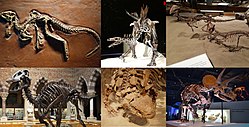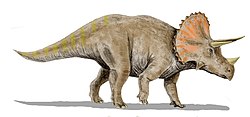Ornithischia
| Ornithischia | |
|---|---|
 Seks forskellige arter fra Ornithischia. I læseretningen: Heterodontosaurus tucki, Stegosaurus stenops, Scolosaurus thronus, Edmontosaurus annectens, Stegoceras validum og Triceratops horridus. | |
| Videnskabelig klassifikation | |
| Rige | Animalia (Dyr) |
| Række | Chordata (Chordater) |
| Underrække | Vertebrata (Hvirveldyr) |
| Overklasse | Tetrapoda (Tetrapoder) |
| Klasse | Reptilia (Krybdyr) |
| Overorden | †Dinosauria (Dinosaurer) |
| Orden | †Ornithischia |
| Udvalgte slægter | |
| Hjælp til læsning af taksobokse | |
Ornithischia er en uddød gruppe af primært planteædende dinosaurer, der var karakteriseret af et bækkenparti, der minder om fuglenes.[1] Navnet Ornithischia ('med fuglebækken') afspejler denne lighed, idet det er afledt af de oldgræske ord ornith- (ὀρνιθ-), der betyder "fra en fugl" og ischion (ἴσχιον), flertal ischia, der betyder "hofteled". Fugle er dog kun fjernt i familie med denne gruppe, da fugle er theropoder.[1]
Velkendte ornithischier omfattes af grupperne ceratopsier (fx Triceratops), Thyreophora (fx Stegosaurus og Ankylosaurus), pachycephalosaurer og ornithopoder.[1] Der er stærk evidens for, at visse grupper af ornithischier levede i flok,[1][2] ofte opdelt efter alder, hvor unge individer dannede egne flokke, adskilt fra de voksne.[3] Nogle var i det mindste delvist dækket af hår- eller fjerlignende pels, og der er meget debat om det kan have været primitive fjer hos Tianyulong,[4] Psittacosaurus[5] og Kulindadromeus.[6]
Klassificering
Ornithischia bliver defineret som alle dinosaurer, der er tættere beslægtet med Triceratops horridus Marsh, 1889 end med både Passer domesticus (Linnaeus, 1758) og Saltasaurus loricatus Bonaparte & Powell, 1980.[7] Som det ses af kladogrammerne nedenfor består gruppen Genasauria af Thyreophora og Neornithischia. Thyreophora omfatter Stegosauria (som den pansrede Stegosaurus) og Ankylosauria (som Ankylosaurus). Neornithischia omfatter flere basale taksa: Marginocephalia (Ceratopsia og Pachycephalosauria) og Ornithopoda (inklusiv andenæbsøgler (hadrosaurer) som Edmontosaurus). Cerapoda er et relativt nyt koncept (Sereno, 1986).
Kladogrammet nedenfor følger en analyse fra 2009 af Zheng et al. Alle testede medlemmer af Heterodontosauridae danner en polytomi.[8]
| Ornithischia |
| |||||||||||||||||||||||||||||||||||||||||||||||||||||||||||||||||||||||||||||||||||||||||||||||||||
Kladogram efter Butler et al., 2011. Ornithopoda inkluderer Hypsilophodon, Jeholosaurus og andre.[4]
| Ornithischia |
| |||||||||||||||||||||||||||||||||||||||||||||||||||||||||||||||||||||||||||||||||||||||
Referencer
- ^ a b c d Fastovsky, David E.; Weishampel, David B. (2012). Dinosaurs: A Concise Natural History. Cambridge: Cambridge University Press. ISBN 978-1107276468.
- ^ Qi, Zhao; Barrett, Paul M.; Eberth, David A. (2007-09-01). "Social Behaviour and Mass Mortality in the Basal Ceratopsian Dinosaur Psittacosaurus (early Cretaceous, People's Republic of China)". Palaeontology (engelsk). 50 (5): 1023-1029. doi:10.1111/j.1475-4983.2007.00709.x. ISSN 1475-4983.
- ^ Zhao, Q. (2013). "Juvenile-only clusters and behaviour of the Early Cretaceous dinosaur Psittacosaurus". Acta Palaeontologica Polonica. doi:10.4202/app.2012.0128.
- ^ a b Richard J. Butler, Jin Liyong, Chen Jun, Pascal Godefroit (maj 2011). "The postcranial osteology and phylogenetic position of the small ornithischian dinosaur Changchunsaurus parvus from the Quantou Formation (Cretaceous: Aptian–Cenomanian) of Jilin Province, north-eastern China". Palaeontology. 54 (3): 667-683. doi:10.1111/j.1475-4983.2011.01046.x.
{{cite journal}}: CS1-vedligeholdelse: Flere navne: authors list (link) - ^ Mayr, Gerald; Peters, Stefan D.; Plodowski, Gerhard; Vogel, Olaf (2002-08-01). "Bristle-like integumentary structures at the tail of the horned dinosaur Psittacosaurus". Naturwissenschaften (engelsk). 89 (8): 361-365. doi:10.1007/s00114-002-0339-6. ISSN 0028-1042. PMID 12435037.
- ^ Godefroit, P.; Sinitsa, S.M.; Dhouailly, D.; Bolotsky, Y.L.; Sizov, A.V.; McNamara, M.E.; Benton, M.J.; Spagna, P. (2014). "A Jurassic ornithischian dinosaur from Siberia with both feathers and scales" (PDF). Science. 345 (6195): 451-455. doi:10.1126/science.1253351. hdl:1983/a7ae6dfb-55bf-4ca4-bd8b-a5ea5f323103. PMID 25061209. Arkiveret fra originalen (PDF) 9. februar 2019. Hentet 13. maj 2019.
- ^ Butler, Richard; Upchurch, Paul; Norman, David (2008). "The phylogeny of ornithischian dinosaurs". Journal of Systematic Palaeontology. 6 (1): 1-40. doi:10.1017/S1477201907002271.
- ^ Zheng, Xiao-Ting; You, Hai-Lu; Xu, Xing; Dong, Zhi-Ming (19. marts 2009). "An Early Cretaceous heterodontosaurid dinosaur with filamentous integumentary structures". Nature. 458 (7236): 333-336. doi:10.1038/nature07856. PMID 19295609.
Eksterne henvisninger
|
Medier brugt på denne side
Forfatter/Opretter: No machine-readable author provided. ArthurWeasley~commonswiki assumed (based on copyright claims)., Licens: CC BY 2.5
Agilisaurus, pencil drawing, version 2, based on the skeleton pictured at [1]
Author:User:ArthurWeasley(c) I, Steveoc 86, CC BY 2.5
Parasaurolophus walkeri restoration,
- • Images of Parasaurolophus skulls were used as reference.
- • Skin impressions are known in Parasaruolophus. It's known to had 'tubercilated' skin similar to other hadrosaurs. (Parks 1922, Parasaruolophus Walkeri, A new Genus of crested Trachont Dinosaur.) (Farke et al. 2013 Ontogeny in the tube-crested dinosaur Parasaurolophus (Hadrosauridae) and heterochrony in hadrosaurids.)
- Known Parasaurolophus skin impressions aren't extensive and don't show all the details. Some of the skin details shown here are speculative but based on those described for another hadrosaur fossil that preserves more extensive skin impressions. [1]
- The frill running down the top of the back is not known in Parasaurolophus. Frills/dermal ridges are known in a few hadrosarus. The one shown here is based loosely on the close relative Corythosaurus (Kennith Karpenter, 1999, Eggs, Nests, and Baby Dinosaurs, A Look at Dinosaur Reproduction.)
- • The colours and/or patterns, as with most restorations of prehistoric creatures, are speculative.
References
- ↑ Anderson, Brian G.; Barrick, Reese E.; Droser, Mary L.; Stadtman, Kennith L. (1999) "Hadrosaur Skin Impressions from the Upper Cretaceous Nelsen Formation, Book Cliffs, Utah: Morphology and Paleoenvironmental Context" in Vertebrate Paleontology in Utah, Category:New York: Utah Geological Survey, pp. 295–302 ISBN: 1557916349, 9781557916341.
Forfatter/Opretter: Nobu Tamura (http://spinops.blogspot.com), Licens: CC BY 3.0
Psittacosaurus mongoliensis. Note that the specimen with preserved pigmentation was shown to not belong to this particular species of Psittacosaurus, so the findings may not apply here.[1]
Forfatter/Opretter: Nobu Tamura (http://spinops.blogspot.com), Licens: CC BY 2.5
Stegosaurus stenops, a stegosaur from the Late Jurassic of North America, pencil drawing
Forfatter/Opretter: Nobu Tamura (http://spinops.blogspot.com), Licens: CC BY 3.0
Scutellosaurus lawleri, an ornithischian from the Early Jurassic of North America, pencil drawing, digital coloring
Edmontonia rugosidens.
Forfatter/Opretter: Tomopteryx, Licens: CC BY-SA 3.0
Orodromeus reconstruction by Tom Parker (Tomopteryx/Tomozaurs).
Forfatter/Opretter: Nobu Tamura (http://spinops.blogspot.com), Licens: CC BY 2.5
Triceratops horridus, a ceratopsian from the Late Cretaceous of North America, pencil drawing
Forfatter/Opretter: Jordan Mallon, Licens: CC BY-SA 2.5
Sketch of a pachycephalosaur of uncertain systematical position and still (2003) not formally described. Its remains were found in the "Sandy Quarry" of the Hell Creek Formation, near Buffalo, South Dakota (USA). Initially reconstructed as Pachycephalosaurus wyomingensis by Michael Triebold later many attendees of an international symposium referred the remains to Stygimoloch spinifer because of the prominent spikes on the back of the skull.
Forfatter/Opretter: Jack Mayer Wood, Licens: CC BY-SA 4.0
Illustration of the Jurassic thyreophoran Scelidosaurus harrisonii, adopting a bipedal stance as evidenced by the Holy Cross Mountain trackways (Gierliński, Gregard (1999). "Tracks of a large thyreophoran from the Early Jurassic of Poland").
Forfatter/Opretter:
- User:Daderot 2. Jeremy Knight 3. Cherrysweetdeal 4: Kevin Walsh 5: Sebastian Bergmann 6. User:Agsftw
Montage of ornithischians. Clockwise from upper left: Heterodontosaurus tucki, Stegosaurus stenops, Stegoceras validum, Triceratops horridus, Scolosaurus thronus, and Edmontosaurus annectens. This is a collection of six works already found in Wikimedia Commons:
- File:Heterodontosaurus tucki cast - University of California Museum of Paleontology - Berkeley, CA - DSC04696.JPG
- File:Stegosaurus (Natural History Museum, London).jpg
- File:Euoplocephalus Royal Tyrell.jpg
- File:Oxford Edmontosaurus.jpg
- File:Royal Tyrrell Museum Stegoceras.jpg
- File:Triceratops Specimen at the Houston Museum of Natural Science.JPG
Forfatter/Opretter: Smokeybjb, Licens: CC BY-SA 3.0
Life restoration of Fruitadens haagarorum.
- Based on figure 1 of "Lower limits of ornithischian dinosaur body size inferred from a new Upper Jurassic heterodontosaurid from North America" by Richard J. Butler, Peter M. Galton, Laura B. Porro, Luis M. Chiappe, Donald M. Henderson, and Gregory M. Erinkson. Proceedings of the Royal Society B doi:10.1098/rspb.2009.1494.
- The filamentous integumentary structures are speculative and based on those of the related genus Tianyulong.
Forfatter/Opretter: User:ArthurWeasley, Licens: CC BY 2.5
Hypsilophodon, pencil drawing













